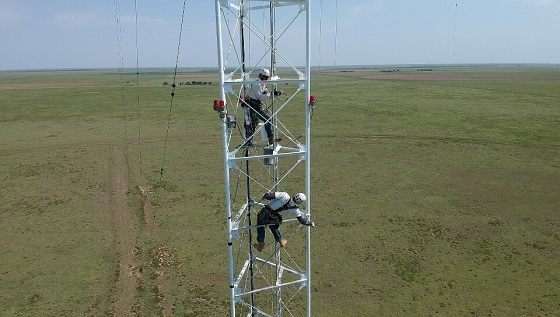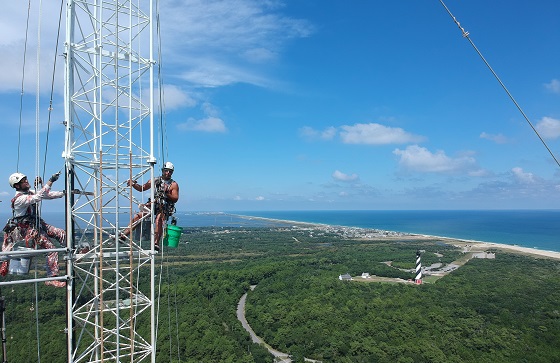During World War II, the United States developed a radio navigation system known as LORAN, short for long-range aids to navigation. By the end of the war, 72 LORAN stations had been built around the world. The system was used extensively by the military — for both ships and aircraft — and was later used commercially and recreationally. LORAN has since been decommissioned, and the signal has ceased transmitting, replaced by satellite global positioning (GPS). However, many of the original towers still stand.
The skinny, lattice-steel towers can reach anywhere from 600 feet (182.9 m) tall and up. A Federal Aviation Administration (FAA) rule states that all structures exceeding 200 feet (61.0 m) above ground must be marked with tower lights and/or specific colors or patterns.
Who Does That?
LORAN towers are under the oversight of the U.S. Coast Guard, who commissioned the repainting of five of the towers in 2018. Northern Pride Communications, Inc., which works frequently with the Coast Guard and had been asked to bid on the repainting work, subcontracted Base Painters for the project.
Base Painters is known for applying high-performance coatings while suspended by rope high above ground. “A lot of people don’t do 700-foot [213.4 m] radio towers. We specialize in everything above two stories that somebody else can’t get to readily or easily,” said Rich Purnell, CEO of the group. “We spend 100 percent of our time on rope, painting stuff. It’s pretty fun!”
The five towers painted by Base last year were located in New Jersey, Wyoming, Oklahoma, North Carolina, and Washington, D.C. A four-man crew worked on each tower — three men up on the tower and one on the ground.
Purnell explained what’s involved in climbing the towers: “These towers usually have ladders, but if they don’t, you’re climbing the lattice, the tower itself. For a 700-foot [213.4 m] tower, the guys climb for about 45 minutes to get to the top. They climb via cable grabs or lanyards and then set up ropes that are attached to separate anchors. You have to account for that time.”
It Seems Daunting
LORAN towers and other tall structures that are close to flight paths need to be painted aviation orange and white, and the color has to be kept to aviation standards. The FAA has an “In-Service Aviation Orange Color Tolerance Chart,” which is used to determine whether a tower needs to be repainted. The chart has a cut-out window, so that when the chart is placed onto the tower surface, it is easy to see whether the orange is within tolerance. When the color has faded too much or the gloss has disappeared, it’s time to repaint.
The five LORAN towers recoated by Base Painters in 2018 were not in major disrepair — they just needed a fresh coat to come back to color standards — so the prep work was minimal. Purnell recalled, “Those ones were somewhat simple. We used simple hand tools and HEPA [high-efficiency particulate air] vacuums for the scraping of any paint chips. Then if there was rust, it got ground down with a Bristle Blaster from Montipower. We spot primed using PPG’s KL 4400 Series Zinc, then we applied primer and a couple coats of paint. It seems daunting, but some of those towers just aren’t really in bad shape.”

The paint chips had to be vacuumed in case they contained lead. Lead-based paint was discontinued for residential use in 1978 in the United States, but many utility and transmission towers were erected several decades ago when lead paint was still used. “Although there wasn’t a report that said these towers had lead paint, we assumed,” stated Purnell.
Once the surface prep was complete, a 700-foot-tall (213.4 m) tower, such as the one in Cape May, New Jersey, required seven bands of color: four orange and three white. The entire length of the tower had to be repainted, with each band signifying 100 feet (30.5 m) of elevation. The color bands were developed “back in the ’20s and ’30s,” said Purnell, who is currently studying to get his private pilot’s license. “When aviation was just beginning, people would have to visually see markers like that. When a pilot would see nine bands of color on a tower, for example, he knew that tower was 900 feet [274.3 m] tall. The system has been replaced by GPS, but they’ve kept the markings. It’s fascinating.”
Orange You Glad It’s Not Taller?
Since LORAN towers were built using a structural steel lattice, they have less surface area than, say, a cylindrical tower. However, according to Purnell, “they are harder to paint and take more time. Once our crew is up in the air, it’s a matter of getting into all the corners, the crevices, the bolts.”
The three men working on the tower would go up with 2 to 3 gallons (7.6–11.4 L) apiece in 5-gallon (18.9 L) buckets. When one person was ready for more paint, the man on the ground hauled the next load of paint up and lowered the empty bucket to refresh it. All of that was done with a haul line. Each coat on each band required a total of 5 gallons (18.9 L) of paint.
The Base Painters crew used 4-inch (10.2 cm) rollers and bristle brushes to apply the PPG Pitt Tech Plus Gloss in aviation orange and white. The coatings were applied to product-specified thicknesses — an average of 6 mils wet for the gloss topcoat, or 152.4 microns — and checked with wet film thickness gages.
Because the towers varied in height, each recoat job had its own time frame. According to Purnell, “We figure with the climbing and the painting, you can do between 50 and 75 feet [15.2–22.9 m] a day with one coat and three guys on the tower. It depends on what the tower needs. If it’s a 700-foot [213.4 m] tower, you’re looking at up to two weeks for two coats of paint and all the prep work.”
All Base Painters crew members are certified for U.S. Occupational Safety and Health Administration (OSHA) fall protection. They have training through the Society of Professional Rope Access Technicians (SPRAT) for power climbing. In fact, Purnell said the company typically hires people who have done “a lot of mountaineering or rock climbing, because they’re used to being up on a rock face for days at a time. When they get to be 700 feet [213.4 m] up, it’s best to stay up there all day and do an 8- or 10-hour shift on the ropes. They’re even taking their lunch breaks up on the tower.”
A Climbing Octopus
Imagine you are climbing a tower carrying paint, brushes, rollers, other equipment, and even food. You can understand what the Base Painters crew experienced. “For these jobs, we actually had 800-foot [243.8 m] ropes,” said Purnell. “The guys would start at the top, and they would rappel down. Depending on where you were, you would have 600 feet [182.9 m] of rope below you that you had to manage as well because it’s attached to you. That’s heavy. Your 5-gallon [18.9 L] bucket of paint is pretty heavy. It’s a workout. The guys even carry a seat with them, so when they’re sitting in the harness they’re actually sitting down and not just hanging. You have all kinds of stuff tethered to you, and you look like a little octopus after a while.”
Base Painters relies on Marlow for all its rope. Petzl USA provides full-body harnesses, descent devices, as well as a backup device called the ASAP. PMI out of Denver, Colorado, also supplies some gear used by Purnell and his team.
Still Standing
LORAN may seem like an ancient technology, but it’s not that far removed. In fact, the fundamentals of GPS are based on the LORAN concepts of time differentials, and fishermen are still using the system in the 21st century. Some who served at LORAN stations around the world have posted stories online about the early days of radio navigation, when they may have been 21 years old and fresh-faced, but they were duly responsible for keeping the signal “on air and within tolerance” and regularly climbing the towers to inspect them.
Several LORAN towers, such as the 1,350-foot (411.5 m) tower that once stood in Port Clarence, Alaska, have been torn down since they were decommissioned in 2010. Yet many remain, the highest landmarks around, with their orange and white bands a telling signal of things past but not forgotten.
Editor’s note: Reprinted with permission from Infrastructure Insights (May 2019).
